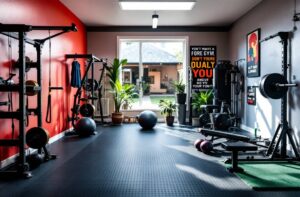Strong legs are essential for a wide range of daily activities, from walking and running to lifting and carrying. Building and maintaining leg strength not only enhances athletic performance but also supports overall mobility and helps prevent injuries.
One popular exercise known for effectively targeting the legs is the hack squat. This exercise engages multiple muscle groups, including the quadriceps, hamstrings, and glutes, providing a comprehensive lower body workout. However, there are situations where alternatives to hack squats might be necessary.
Factors such as limited access to equipment, existing injuries, or simply the desire to add variety to a workout routine can all prompt individuals to seek out different exercises. Exploring various alternatives can ensure a well-rounded fitness regimen that stays both effective and engaging.
Why Consider Alternatives to Hack Squats?
Potential Limitations of Hack Squats
While hack squats are highly effective, they come with certain limitations that might make them less suitable for everyone. For instance, individuals with knee or lower back issues may find the hack squat’s mechanics challenging or even painful.
Additionally, the fixed movement pattern of the hack squat machine can sometimes place undue strain on the joints, making it less ideal for those needing more flexibility in their workout routines.
Equipment Unavailability
Not all gyms are equipped with a hack squat machine, and purchasing one for home use can be costly and space-consuming. This equipment unavailability can constrain your workout options and make it difficult to maintain a consistent leg strengthening routine.
Safety Concerns for Certain Individuals
For beginners or those with existing injuries, the hack squat might pose safety risks. The position and movement required can be tricky to master, which increases the risk of improper form and consequently, injury. It’s essential to consider exercises that offer a safer option while still effectively targeting the leg muscles.
Benefits of Using Alternative Exercises
Incorporating alternative exercises can address the limitations associated with hack squats. These alternatives can offer similar, if not better, muscle engagement and strength-building benefits without the associated risks. By providing options, individuals can select exercises that best suit their specific needs, comfort levels, and fitness goals.
Variety in Workouts to Prevent Plateau
Relying solely on one exercise can lead to a plateau, where progress stalls despite continued effort. Mixing in a variety of leg exercises ensures that different muscle groups are continually challenged, promoting ongoing strength gains and preventing boredom.
Addressing Specific Muscle Weaknesses
Different exercises target muscles in unique ways. By incorporating alternatives to hack squats, you can focus on strengthening specific muscle groups that may be weaker or underdeveloped. This balanced approach to leg workouts ensures comprehensive muscle development and enhanced overall performance.
Catering to Different Fitness Levels
Hack squat alternatives cater to a wide array of fitness levels, from beginners to advanced athletes. By choosing exercises that match your current fitness level and gradually increasing the intensity, you can build strength safely and effectively. This adaptability makes it easier for everyone to include effective leg exercises in their fitness routine, regardless of their starting point.
Top Alternatives to Hack Squats
1. Goblet Squats
Description and Muscles Worked
Goblet squats are a versatile and accessible exercise that primarily targets the quadriceps, hamstrings, glutes, and core muscles. This exercise is performed by holding a dumbbell or kettlebell at chest level, mimicking the movement of a traditional squat but with added resistance.
How to Perform Them Safely
To perform goblet squats safely, follow these steps:
- Stand with your feet shoulder-width apart, holding a dumbbell or kettlebell close to your chest with both hands.
- Engage your core and keep your chest up as you begin to bend your knees and hips, lowering your body into a squat position.
- Ensure your knees track over your toes and avoid letting them cave inward. Your thighs should be parallel to the ground.
- Push through your heels to stand back up, fully extending your hips and knees to return to the starting position.
- Repeat for the desired number of repetitions, maintaining a controlled movement throughout.
Benefits of Goblet Squats
Goblet squats offer several benefits, making them an excellent alternative to hack squats. They help improve overall lower body strength, enhance core stability, and promote proper squat form, reducing the risk of injury. Additionally, goblet squats can be easily modified by adjusting the weight or performing the exercise on an elevated surface, making them suitable for all fitness levels.
2. Bulgarian Split Squats
Description and Muscles Worked
Bulgarian split squats are a powerful unilateral exercise emphasizing one leg at a time, making them an excellent choice for improving balance, stability, and overall leg strength. This exercise predominantly works the quadriceps, hamstrings, glutes, and even the core, offering a comprehensive lower body workout.
Step-by-Step Guide to Performing Them
To perform Bulgarian split squats safely, follow these steps:
- Stand a few feet in front of a bench or elevated surface.
- Extend one leg behind you and place the top of your foot on the bench.
- Ensure your front foot is far enough forward so that when you squat down, your front knee stays directly over your ankle.
- With your torso upright and core engaged, lower your body by bending your front knee, ensuring your back knee moves down towards the ground.
- Descend until your front thigh is parallel to the ground, keeping your knee aligned over your foot.
- Press through the heel of your front foot to return to the starting position.
- Repeat for the desired number of repetitions before switching legs.
Advantages of Hack Squats
Bulgarian split squats offer numerous advantages over hack squats:
- Improved Balance and Stability: By working one leg at a time, Bulgarian split squats effectively improve balance and stability, crucial for athletic performance and everyday movements.
- Reduced Joint Stress: Unlike the fixed path of a hack squat machine, Bulgarian split squats allow a natural movement pattern, which can reduce stress on the knees and lower back.
- Muscle Imbalances: This unilateral exercise helps identify and correct muscle imbalances between the legs, leading to more symmetrical development and strength.
- Accessibility: No specialized equipment is necessary, as this exercise can be performed with dumbbells or body weight, making it accessible regardless of gym resources.
- Core Engagement: The requirement to maintain balance and posture enhances core activation, providing a secondary benefit of improved core strength.
3. Leg Press
Description and Muscles Worked
The leg press is a fundamental exercise that targets the lower body, specifically engaging the quadriceps, hamstrings, glutes, and calves. Performed on a leg press machine, this exercise allows for controlled and consistent resistance, making it a popular choice for both beginners and seasoned athletes aiming to build leg strength.
Instructions for Using the Leg Press Machine Correctly
To use the leg press machine safely and effectively, follow these steps:
- Positioning: Sit on the machine with your back and head pressed against the support. Place your feet shoulder-width apart on the footplate, and ensure your legs form a 90-degree angle at the knees.
- Starting Stance: Grasp the support handles, and release the safety handles to allow movement. Your feet should be flat on the plate, ensuring your knees are in line with your feet.
- Lowering Phase: Slowly lower the footplate by bending your knees, allowing them to come towards your chest. Ensure your back remains flat against the pad, and do not let your knees move inward.
- Pressing Phase: Push through your heels to return to the starting position, fully extending your legs without locking your knees.
- Repetition: Repeat for the desired number of repetitions. Use controlled movements to maintain good form and prevent injury.
Why Leg Press is a Good Substitute
The leg press is an excellent substitute for hack squats for several reasons:
- Controlled Movement: The leg press enables a controlled range of motion and adjustable resistance, making it suitable for individuals of all fitness levels.
- Reduced Joint Stress: By providing support to the back and reducing the axial load on the spine, the leg press machine minimizes stress on the joints, particularly the knees and lower back.
- Versatility: The leg press allows for variations in foot placement, which can target different muscle groups more intensely and customize workouts to individual needs.
- Muscle Isolation: As a closed-chain exercise, the leg press is especially effective at isolating and focusing on specific muscle groups, encouraging balanced muscle development.
- Safety: The stable and supported environment of the leg press machine lowers the risk of injury, making it a safer option for those recovering from injury or new to strength training.
4. Front Squats
Description and Muscles Worked
Front squats are a dynamic compound exercise that primarily focuses on the quadriceps while also engaging the glutes, hamstrings, and core muscles. This exercise requires holding a barbell at the front of the shoulders, necessitating greater core stability and upper body strength compared to other squat variations.
Step-by-Step Guide to Performing Them
To perform front squats safely and effectively, follow these steps:
- Bar Position: Position a barbell across the front of your shoulders, using either a clean grip (arms crossed over the bar) or a front rack position (palms facing up, elbows pointing forward).
- Foot Placement: Stand with your feet shoulder-width apart and toes slightly pointed outwards.
- Engagement and Alignment: Engage your core and keep your back straight, with your chest lifted and elbows high to support the bar.
- Descent: Lower your body by pushing your hips back and bending your knees, ensuring that your spine remains neutral and your knees track over your toes.
- Depth: Descend until your thighs are at least parallel to the ground, maintaining an upright torso throughout the movement.
- Ascent: Push through your heels to return to the starting position, keeping your chest up and elbows high to maintain bar stability.
- Repetition: Repeat for the desired number of repetitions, focusing on controlled movement and correct form.
Specific Benefits for Leg and Core Strength
- Enhanced Quadriceps Engagement: The front squat places more emphasis on the quadriceps than other squat variations, promoting enhanced development and strength in the front of the thighs.
- Improved Core Stability: Front squats significantly improve core strength and stability by requiring the core to stabilize the torso and maintain an upright position.
- Better Postural Alignment: Front squats encourage proper posture by demanding a more upright torso position, which can translate into improved overall body alignment and reduced risk of injury.
- Balanced Muscle Development: With a focus on both the quads and the core, front squats develop balanced muscle strength, improving overall functional fitness.
- Efficiency: As a compound movement, front squats engage multiple muscle groups simultaneously, making them an efficient exercise for building lower body and core strength.
5. Step-Ups
Detailed Description and Target Muscles
Step-ups are a functional lower-body exercise that primarily targets the quadriceps, hamstrings, glutes, and calves. This exercise mimics natural movements such as walking upstairs, making it valuable for enhancing daily movement patterns and overall leg strength.
How to Do Step-Ups with Correct Form
To perform step-ups safely and effectively, follow these steps:
- Equipment Setup: Find a sturdy, elevated platform or step, approximately knee height. You can use body weight or hold dumbbells in each hand for added resistance.
- Starting Position: Stand upright facing the platform with your feet shoulder-width apart and arms relaxed at your sides (or holding dumbbells).
- Engagement and Lift: Engage your core and glutes. Step onto the platform with your right foot, pressing through the heel to lift your body upward.
- Full Extension: As you step up, bring your left foot to meet your right foot on the platform, ensuring full hip and knee extension.
- Controlled Descent: Step down with your right foot first, followed by the left foot, returning to the starting position with controlled movement.
- Alternating Steps: Repeat the movement by stepping up with the left foot next, alternating between legs with each repetition.
- Repetition: Perform for the desired number of repetitions on each leg, maintaining good form and controlled movements throughout.
Benefits of Functional Fitness and Balance
- Improved Leg Strength: Step-ups effectively build strength in the quadriceps, hamstrings, and glutes, which are critical for various daily activities and athletic performance.
- Enhanced Balance and Coordination: The single-leg focus of step-ups improves balance and coordination, fostering better neuromuscular control and stability.
- Functional Movements: This exercise mimics the natural movement patterns involved in climbing stairs, making it practical and directly applicable to everyday tasks.
- Core Activation: The need to stabilize the body while stepping up and down engages the core muscles, promoting overall core strength and stability.
- Low Impact: Step-ups are a low-impact exercise, making them a joint-friendly option for individuals looking to increase strength and function without excessive stress on the joints.
- Versatility: Variations in height, load, and tempo can easily modify the difficulty of step-ups, catering to a wide range of fitness levels and training goals.
Tips for Safe and Effective Leg Workouts
Importance of Warm-up and Cool-down
Warming up before a leg workout is essential to prepare your muscles and joints for the upcoming exercise, reducing the risk of injury. A proper warm-up should include dynamic stretches and light cardio movements, such as leg swings, lunges, or brisk walking, to increase blood flow and flexibility.
Similarly, cooling down after your workout helps to gradually lower your heart rate and prevent muscle stiffness. Incorporate static stretches focusing on the quadriceps, hamstrings, calves, and glutes to promote recovery and maintain muscle flexibility.
Proper Form and Technique
Maintaining proper form and technique is crucial for the effectiveness of your leg workouts and to minimize the risk of injury. Ensure you are using a full range of motion, keeping your spine neutral, and activating the correct muscle groups during each exercise.
Pay attention to your body alignment, avoid locking your joints, and use a controlled, steady pace. If you’re unsure about your form, consider seeking guidance from a fitness professional or watching instructional videos.
Listening to Your Body to Avoid Injury
Listening to your body is vital in preventing overexertion and injuries. It’s important to recognize the difference between muscle soreness caused by a challenging workout and pain that indicates a potential injury. If you experience sharp or persistent pain, stop the exercise immediately and consult a healthcare professional if necessary. Gradually increase the intensity of your workouts and avoid pushing through pain to ensure long-term health and safety.
Incorporating a Variety of Exercises
To achieve balanced leg development, incorporate a variety of exercises targeting different muscle groups. Combining compound movements like squats and deadlifts with isolation exercises such as leg curls and extensions can ensure that your quadriceps, hamstrings, glutes, and calves are all being effectively worked. Additionally, varying your workout routine can prevent boredom and keep your muscles challenged.
Importance of Rest and Recovery
Rest and recovery are just as important as the workouts themselves for muscle growth and strength gains. Allow adequate time for your muscles to recover by including rest days in your workout schedule. Incorporate active recovery activities like light stretching, yoga, or walking to promote blood flow and aid in muscle repair.
Ensure you get enough sleep and maintain a nutritious diet to support your overall recovery process. Remember, overtraining can lead to burnout and increase the risk of injury, so listen to your body and prioritize recovery.
Conclusion
Recap of the importance of leg strength and the benefits of hack squat alternatives: Strong legs are fundamental for overall fitness and daily functional movements. Hack squat alternatives, such as step-ups, lunges, and Bulgarian split squats, offer varied ways to achieve leg strength without necessitating specialized equipment. These exercises not only enhance leg strength but also improve balance, coordination, and core stability, promoting a well-rounded fitness profile.
Encouragement to try different exercises and find what works best for the individual: Embracing a variety of leg exercises can help discover what best suits your fitness levels, preferences, and goals. Whether you enjoy the simplicity of bodyweight exercises or prefer the added resistance of dumbbells, experimenting with different movements can keep your workouts fresh and engaging. Finding what works best for you is key to staying motivated and consistent in your fitness journey.
Final thoughts on staying safe and making progress in leg workouts: Safety should always be a priority. Ensure correct form and technique, listen to your body, and incorporate rest days for optimal recovery. Consistent progress comes from a balanced approach to challenging workouts and sufficient recovery.
Remember, it’s not just about lifting heavier weights or doing more reps; it’s about performing each exercise with proper form and steadily improving over time. Stay patient, stay committed, and most importantly, enjoy the process of enhancing your leg strength and overall fitness.
We’d love to hear from you! Share your favorite hack squat alternatives in the comments below. Whether it’s a creative variation or a tried-and-true exercise that works best for you, your tips and experiences can inspire and help others in their fitness journey.
Feel free to ask any questions or start a discussion. We’re here to support each other, so let’s engage and exchange knowledge for safer and more effective leg workouts. Your input is valuable – let’s build a stronger fitness community together!
Frequently Asked Questions about Hack Squat Alternatives
1. What is a hack squat alternative?
A hack squat alternative refers to exercises that can replace the traditional hack squat, often utilizing less specialized equipment while offering similar benefits in terms of leg strength and development.
2. Why should I consider hack squat alternatives?
Hack squat alternatives provide a versatile and accessible way to build leg strength without the need for dedicated hack squat machines. They can be performed in various settings, including at home or in a gym, using minimal equipment.
3. What are some common hack squat alternatives?
Some popular hack squat alternatives include step-ups, lunges, Bulgarian split squats, goblet squats, and leg presses. These exercises target the same muscle groups and offer comparable strength-building benefits.
4. How do hack squat alternatives compare to the traditional hack squat?
Hack squat alternatives can offer more flexibility and variety in your workout routine. While the traditional hack squat is effective, alternatives can engage additional muscle groups and improve balance and coordination.
5. Can I replace the hack squat entirely with these alternatives?
Yes, you can effectively replace the hack squat with other exercises while still achieving significant leg strength and muscle development. Mixing different exercises can also prevent plateaus and keep your workouts interesting.
6. Are hack squat alternatives suitable for all fitness levels?
Absolutely! Hack squat alternatives can be modified to suit beginners, intermediate, and advanced fitness levels by adjusting exercise intensity, load, and repetition schemes.
7. Do I need any special equipment for hack squat alternatives?
Many hack squat alternatives require minimal equipment, such as dumbbells or resistance bands. Bodyweight variations are also effective and convenient for home workouts.
8. How often should I perform hack squat alternatives?
It’s important to allow adequate rest between leg workouts. Aim to include hack squat alternatives in your routine 2-3 times per week, ensuring you balance them with other exercises and recovery days.
9. What precautions should I take when performing hack squat alternatives?
Always warm up before your workout and maintain proper form to avoid injury. Listen to your body, and don’t push through pain. If unsure about your technique, seek guidance from a fitness expert.
10. Can hack squat alternatives help improve my athletic performance?
Yes, incorporating these alternatives can enhance leg strength, power, and stability, which are crucial for various athletic activities. These exercises support overall functional fitness and can contribute to better performance in sports and daily activities.
We hope these FAQs help you understand more about hack squat alternatives and how to integrate them into your fitness routine!





















